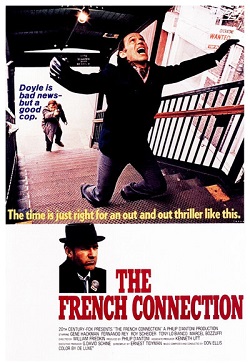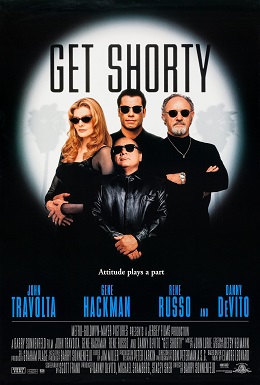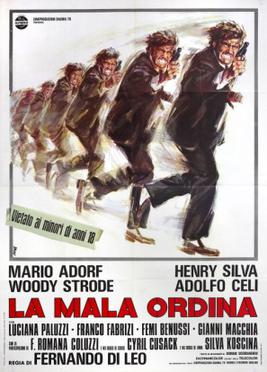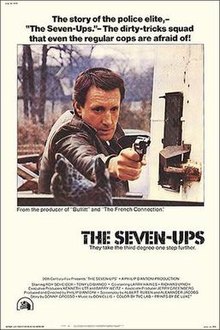
The French Connection is a 1971 American neo-noir action thriller film directed by William Friedkin and starring Gene Hackman, Roy Scheider and Fernando Rey. The screenplay, written by Ernest Tidyman, is based on Robin Moore's 1969 non-fiction book of the same name. It tells the story of fictional NYPD detectives Jimmy "Popeye" Doyle and Buddy "Cloudy" Russo, whose real-life counterparts were narcotics detectives Eddie Egan and Sonny Grosso, in pursuit of wealthy French heroin smuggler Alain Charnier.

Terrence Stephen McQueen was an American actor and racing driver. His antihero persona, emphasized during the height of the counterculture of the 1960s, made him a top box-office draw for his films of the 1960s and 1970s. He was nicknamed the "King of Cool" and used the alias Harvey Mushman in motor races.

Roy Richard Scheider was an American actor and amateur boxer. Described by AllMovie as "one of the most unique and distinguished of all Hollywood actors", he gained fame for his leading and supporting roles in celebrated films from the 1970s through to the early to mid-1980s. He was nominated for two Academy Awards, a Golden Globe Award, and a BAFTA Award.

Bullitt is a 1968 American neo-noir action thriller film directed by Peter Yates and produced by Philip D'Antoni. The picture stars Steve McQueen, Robert Vaughn, Jacqueline Bisset, Don Gordon, Robert Duvall, Simon Oakland and Norman Fell. The screenplay by Alan R. Trustman and Harry Kleiner was based on the 1963 novel Mute Witness by Robert L. Fish, under the pseudonym Robert L. Pike. Lalo Schifrin wrote the original jazz-inspired score.
Arthur Avenue is a street in the Belmont neighborhood of the Bronx, New York City, which serves as the center of the Bronx's "Little Italy". Although the historical and commercial center of Little Italy is Arthur Avenue itself, the area stretches across East 187th Street from Arthur Avenue to Beaumont Avenue, and is similarly lined with delis, bakeries, cafes and various Italian merchants.

To Live and Die in L.A. is a 1985 American neo-noir action crime thriller film directed and co-written by William Friedkin and based on the 1984 novel by former United States Secret Service agent Gerald Petievich, who co-wrote the screenplay with Friedkin. The film features William Petersen, Willem Dafoe and John Pankow among others. Wang Chung composed and performed the original music soundtrack. The film tells the story of the lengths to which two Secret Service agents go to arrest a counterfeiter.
William Carey Loftin was an American professional stuntman, stunt coordinator and actor in the U.S. film industry. He is considered to be one of the film industry's most accomplished stunt drivers. In a lengthy career spanning 61 years, his body of work included classic films such as Thunder Road, Bullitt, Vanishing Point, Duel, and The French Connection. He was posthumously inducted into the AMA Motorcycle Hall of Fame in 2001.

Robbery is a 1967 British crime film directed by Peter Yates and starring Stanley Baker, Joanna Pettet and James Booth. The story is a heavily fictionalised version of the 1963 Great Train Robbery. The film was produced by Stanley Baker and Michael Deeley, for Baker's company Oakhurst Productions.

Peter James Yates was an English film director and producer. He is known for directing such films as Bullitt (1968), John and Mary (1969), The Friends of Eddie Coyle (1973), Breaking Away (1979), and The Dresser (1983). He received nominations for four Academy Awards, three BAFTA Awards, and two Golden Globe Awards.

William Hickman was an American professional stunt driver, stunt coordinator and actor in the U.S. film industry. His film career spanned from the 1950s through to the late 1970s, and included films such as Bullitt, The French Connection and The Seven-Ups.

White Lightning is a 1973 American action film directed by Joseph Sargent, written by William W. Norton, and starring Burt Reynolds, Jennifer Billingsley, Ned Beatty, Bo Hopkins, R. G. Armstrong and Diane Ladd. It marked Laura Dern's film debut.
James Sherwin "Bud" Ekins was an American professional stuntman in the U.S. film industry. He is considered to be one of the film industry's most accomplished stuntmen with a body of work that includes classic films such as The Great Escape and Bullitt. Ekins, acting as stunt double for Steve McQueen while filming The Great Escape, was the rider who performed what is considered to be one of the most famous motorcycle stunts ever performed in a movie. He was recognized for his stunt work by being inducted into the Stuntmen's Hall of Fame.
Salvatore Anthony Grosso, known as Sonny Grosso, was an American film producer, television producer, and NYPD detective, noted for his role in the case made famous in the book and film versions of the French Connection.

96th Street is a major two-way street on the Upper East Side and Upper West Side sections of the New York City borough of Manhattan. It runs in two major sections: between the FDR Drive and Fifth Avenue on the Upper East Side, and between Central Park West and Henry Hudson Parkway on the Upper West Side. The two segments are connected by the 97th Street transverse across Central Park, which links the disconnected segments of 96th and 97th Streets on each side.

Get Shorty is a 1995 American gangster comedy film directed by Barry Sonnenfeld and written by Scott Frank, based on Elmore Leonard's novel of the same name. The film stars John Travolta, Gene Hackman, Rene Russo, Delroy Lindo, James Gandolfini, Dennis Farina, and Danny DeVito. It follows Chili Palmer (Travolta), a Miami mobster and loan shark who inadvertently gets involved in Hollywood feature film production.
Philip D'Antoni was an American film and television producer. He was best known for producing the Academy Award-winning 1971 film The French Connection.

The Italian Connection is a 1972 noir-thriller film directed and co-written by Fernando Di Leo; starring Mario Adorf, Henry Silva, Woody Strode, Adolfo Celi, Luciana Paluzzi, Francesca Romana Coluzzi, Sylva Koscina, and Cyril Cusack.
Frank P. Keller was an American film and television editor with 24 feature film credits from 1958 - 1977. He is noted for the series of films he edited with director Peter Yates, for his four nominations for the Academy Award for Best Film Editing ("Oscars"), and for the "revolutionary" car chase sequence in the film Bullitt (1968) that likely won him the editing Oscar.
Reginald Beck was a British film editor with forty-nine credits from 1932 to 1985. He is noted primarily for films done with Laurence Olivier in the 1940s and with Joseph Losey in the 1960s and 1970s.












